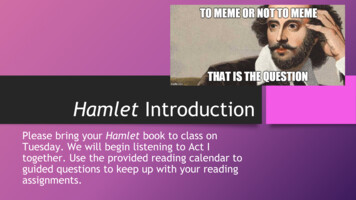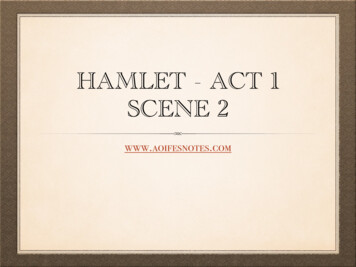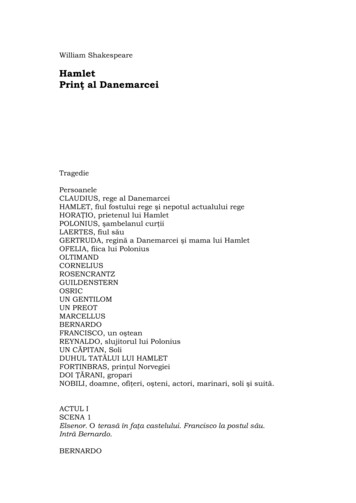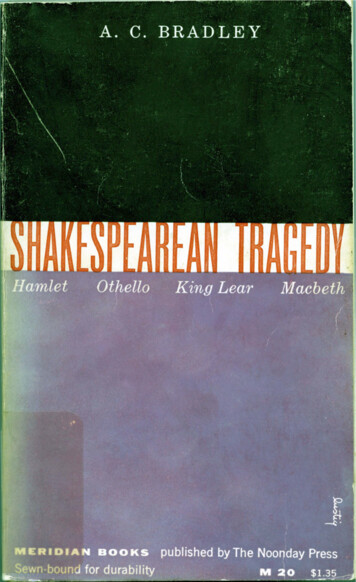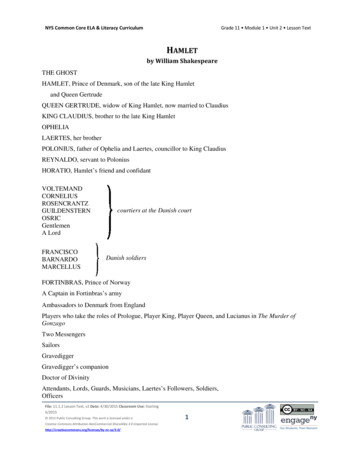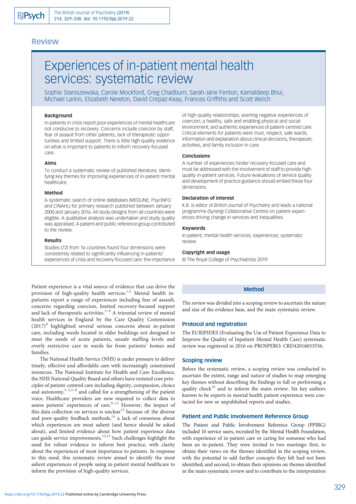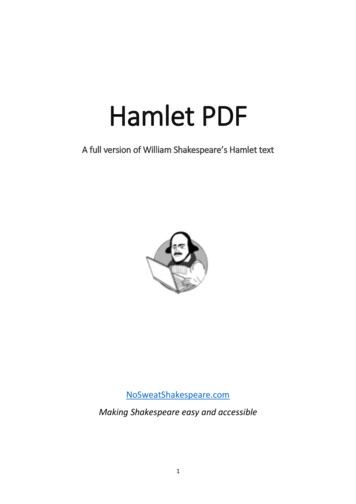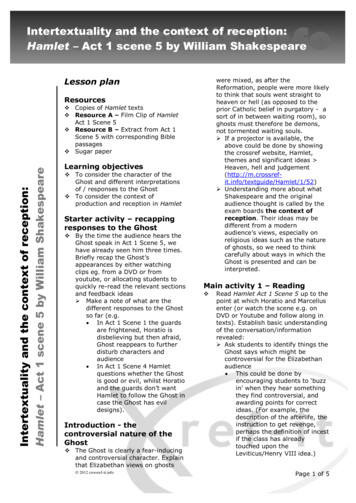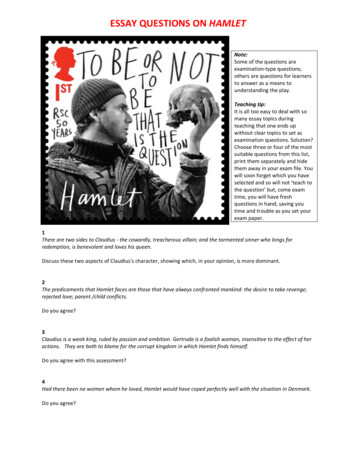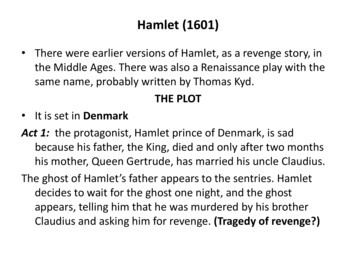
Transcription
Hamlet (1601) There were earlier versions of Hamlet, as a revenge story, inthe Middle Ages. There was also a Renaissance play with thesame name, probably written by Thomas Kyd.THE PLOT It is set in DenmarkAct 1: the protagonist, Hamlet prince of Denmark, is sadbecause his father, the King, died and only after two monthshis mother, Queen Gertrude, has married his uncle Claudius.The ghost of Hamlet’s father appears to the sentries. Hamletdecides to wait for the ghost one night, and the ghostappears, telling him that he was murdered by his brotherClaudius and asking him for revenge. (Tragedy of revenge?)
Act 2: Hamlet pretends to be mad to carry out his plansmore easily. (Appearance vs reality) Polonius, the King’scounsellor, thinks Hamlet is mad because he is in love withhis daughter Ophelia. Polonius and the king secretlyobserve a meeting between Hamlet and Ophelia, butHamlet badly rejects her. Hamlet calls at court a group ofactors and asks them to play “The Murder of Gonzago”, tofind out the truth about his father’s death. (Theatre as away to discover the truth!)Act 3: When the king sees the play, he reacts and he runsaway. Now he knows that King Claudius is guilty and heshould take revenge. However, he is too undecided: hehas the opportunity to kill Claudius but he doesn’tbecause he’s praying. (Doubt and uncertainty, typical of amodern hero, or an anti-hero)
Later, while he’s talking with his mother, he seessomebody hiding behind a curtain. He kills him withhis sword, thinking that it’s Claudius, but it’s Polonius.(Hamlet is not able to make a decision, and when hedecides impulsively, without thinking, he makes amistake!).Act 4: King Claudius sends Hamlet to England to bekilled. In the meantime, Ophelia goes mad and drownsherself. Her brother Laertes comes back home andfinds that both his father and his sister have diedbecause of Hamlet. Hamlet manages to come back toDenmark and Laertes wants to have a duel with him totake revenge.
Act 5: King Claudius plots against Hamlet in the duel:he poisons Laerte’s sword and he prepares somepoisoned wine to offer Hamlet. But during the duelHamlet and Laerte exchange swords and they bothwound each other with the poisoned sword.Gertrude drinks the poisoned wine by mistake. WhenHamlet realizes he’s going to die he finally stabs theking. Before dying, Hamlet tells his friend Horatio tooffer the country to Fortinbras, king of Norway.
Typical themes of revenge tragedies presentin Hamlet: A violent crime has been committed against afamily member of the hero, but law andjustice cannot punish it. Period of doubt Appearance of a ghost Close relationship with the audience throughsoliloquies and asides. Isolation and madness of the hero
Shakespeare’s originality: Shakespeare improves the story: it becomes more than atragedy of revenge: it is a tragedy of will. In fact, he doesn’ttake revenge immediately. He’s full of doubts and hesitations(Is Claudius really guilty? Was his father’s ghost real or was itjust the product of his imagination?). These thoughts kill hisaction. Deep psychological penetration Emphasis on doubt and uncertainty (he was a precursor of20th century drama; Hamlet is a modern hero) Hamlet only pretends to be mad in order to carry out hisplans.
Other important themes in Hamlet Relationship between father and son; mother and son; loverelationship (Ophelia), friendship. The power of the theatre: “the play within the play”, a merefiction, shows the truth. Appearance vs reality: what appears to be true doesn’t correspondto reality, appearance doesn’t often correspond to the real feelingsof people. (This theme is also connected to the sense of doubt andambiguity typical of the 16th century, when the certainties of thepast were disproved or modified). Madness vs sanity: Hamlet pretends to be mad to carry out hisplans more easily (“there’s reason in his madness”, Polonius saysafter talking to him).
Honour: any action to correct a wrong should be reasoned, notemotional (many actions taken impulsively by Hamlet cause greattrouble to other people: Polonius, Ophelia) Action vs inaction (see the monologue): thinking too muchprevents Hamlet from taking action. Hamlet as the first modern hero: like Hamlet, modern man istormented by doubt, by a lack of religious or moralcertainties (which takes him to inaction) and by an inability tocommunicate. Ambiguity of Hamlet’s language: he uses metaphors, similiesand wordplay. His words often have a hidden meaning thatgoes beyond their apparent meaning.
Hamlet’s mourning (Act I, scene II)CLAUDIUSBut now, my cousin Hamlet, and my son—HAMLET (aside) A little more than kin andless than kind.CLAUDIUS How is it that the clouds stillhang on you?HAMLET Not so, my lord. I am too much i'the sun.GERTRUDE Good Hamlet, cast thynighted color off, and let thine eye looklike a friend on Denmark.Do not forever with thy vailèd lidsSeek for thy noble father in the dust.Thou know’st ’tis common. All that livesmust die,Passing through nature to eternity.HAMLET Ay, madam, it is common.GERTRUDEIf it be,Why seems it so particular with thee?CLAUDIUSAnd now, Hamlet, my nephew and my son—HAMLET(speaking so no one else can hear) I little more thana relative, but not lovingCLAUDIUSWhy are you still so gloomy, with a cloud hangingover you?HAMLETIt’s not true, sir. Your son is out in the sun.GERTRUDEMy dear Hamlet, stop wearing these black clothes,and be friendly to the king. You can’t spend yourwhole life with your eyes to the ground rememberingyour noble father. It happens all the time, what livesmust die eventually, passing to eternity.HAMLETYes, mother, it happens all the time.(“common” vulgar)GERTRUDESo why does it seem so particular to you?
HAMLET“Seems,” madam? Nay, it is. I knownot “seems.”'Tis not alone my inky cloak, goodmother,Nor customary suits of solemn black,Nor windy suspiration of forcedbreath,No, nor the fruitful river in the eye,Nor the dejected 'havior of the visage,Together with all forms, moods,shapes of grief,That can denote me truly. Theseindeed “seem,”For they are actions that a man mightplay.But I have that within which passethshow,These but the trappings and the suitsof woe.HAMLET“Seem,” mother? No, it is. I don’tknow what you mean by “seem.”Neither my black clothes, my dearmother, nor my heavy sighs, normy weeping, nor my downcasteyes, nor any other display ofgrief can show what I really feel.It’s true that all these things“seem” like grief, since a personcould use them to fake grief if hewanted to. But I’ve got more realgrief inside me that you could eversee on the surface. These clothesare just a hint of it.
Explain the puns ( plays with words) and metaphors present in the text. What does Hamlet want to express about his relationship with his uncleClaudius? Where and how does Hamlet express the contrast between appearanceand reality? What world does he refer to when he speaks of “appearance”?
Hamlet’s soliloquy (act 3, scene1)The soliloquy is a pause in the action of the play. Hamlet has just decided to call acompany of actors at court to prove the king guilty.Claudius and Polonius hide and spy on him.To be, or not to be? That is the question—Whether ’tis nobler in the mind to sufferThe slings and arrows of outrageous fortune,Or to take arms against a sea of troubles,And, by opposing, end them? To die, to sleep—No more—and by a sleep to say we endThe heartache and the thousand natural shocksThat flesh is heir to—’tis a consummationDevoutly to be wished! To die, to sleep.To sleep, perchance to dream—ay, there’s the rub,For in that sleep of death what dreams may comeWhen we have shuffled off this mortal coil,Must give us pause. There’s the respectThat makes calamity of so long life.Life vs deathAction vs inactionWords related to warDeath as a possible liberationWe are afraid NOT of death, but ofwhat there might be after death!This fear is the reason why we go onliving
For who would bear the whips and scornsof time,Th' oppressor’s wrong, the proud man’scontumely,The pangs of despised love, the law’sdelay,The insolence of office, and the spurnsThat patient merit of th' unworthy takes,When he himself might his quietus makeWith a bare bodkin? Who would fardelsbear,To grunt and sweat under a weary life,But that the dread of something afterdeath,The undiscovered country from whosebournNo traveler returns, puzzles the willAnd makes us rather bear those ills wehaveThan fly to others that we know not of?List of human sufferings:life’s humiliations, the abuse fromsuperiors, the insults of arrogant men,the pangs of not corresponded love,the inefficiency of the legal system, therudeness of people in power, and themistreatment good people have to takefrom bad.It’s the fear of what there might beafter deathThis fear stops our will and makes usaccept all the sufferings of this life.
Thus conscience does make cowards ofus all,And thus the native hue of resolutionIs sicklied o'er with the pale cast ofthought,And enterprises of great pith andmomentWith this regard their currents turnawry,And lose the name of action.Important metaphor: sickness vshealthRESOLUTION is healthyTHOUGHT is an illnessThought infects our ability to makedecisions and so important actionslose their direction.Thought kills action (tragedy of will!)
HAMLET To be, or not to be? That is the question—Whether ’tis nobler in the mind to sufferThe slings and arrows of outrageous fortune,Or to take arms against a sea of troubles,And, by opposing, end them? To die, to sleep—No more—and by a sleep to say we endThe heartache and the thousand natural shocksThat flesh is heir to—’tis a consummationDevoutly to be wished! To die, to sleep.To sleep, perchance to dream—ay, there’s the rub,For in that sleep of death what dreams may comeWhen we have shuffled off this mortal coil,Must give us pause. There’s the respectThat makes calamity of so long life.For who would bear the whips and scorns of time,Th' oppressor’s wrong, the proud man’s contumely,The pangs of despised love, the law’s delay,The insolence of office, and the spurnsThat patient merit of th' unworthy takes,When he himself might his quietus makeWith a bare bodkin? Who would fardels bear,To grunt and sweat under a weary life,But that the dread of something after death,The undiscovered country from whose bournNo traveler returns, puzzles the willAnd makes us rather bear those ills we haveThan fly to others that we know not of?Thus conscience does make cowards of us all,And thus the native hue of resolutionIs sicklied o'er with the pale cast of thought,And enterprises of great pith and momentWith this regard their currents turn awry,And lose the name of action.The question is: is it better to be alive or dead? Is itnobler to put up with all the nasty things that luckthrows your way, or to fight against all those troublesby simply putting an end to them once and for all?Dying, sleeping—that’s all dying is—a sleep that endsall the heartache and shocks that life on earth givesus—that’s an achievement to wish for. To die, tosleep—to sleep, maybe to dream. Ah, but there’s theproblem: in death’s sleep who knows what kind ofdreams might come, after we’ve put the noise andcommotion of life behind us. That’s certainlysomething to worry about. That’s the considerationthat makes us bear our sufferings for so long.After all, who would put up with all life’shumiliations—the abuse from superiors, the insults ofarrogant men, the pangs of unrequited love, theinefficiency of the legal system, the rudeness ofpeople in office, and the mistreatment good peoplehave to take from bad—when you could simply takeout your knife and put an end to that? Who wouldchoose to grunt and sweat through an exhausting life,unless they were afraid of something dreadful afterdeath, the undiscovered country from which novisitor returns, which we wonder about withoutgetting any answers from and which makes us stick tothe evils we know rather than rush off to seek theones we don’t? Fear of death makes us all cowards,and our natural boldness becomes weak with toomuch thinking. Actions that should be carried out atonce get misdirected, and stop being actions at all.
Important themes in the soliloquy: The first lines of the soliloquy (“to be or not to be”, lines 1-5)can be interpreted in two ways and present two importantthemes:life vs death (or stoic attitude vs suicide): is it better to go onliving (and suffering) or to commit suicide and put an end toour suffering?action vs inaction: is it better to remain indifferent and leavethings as they are or to fully realize one’s potential and takeimportant decisions? We choose life because we are afraid of death. The fear ofwhat there is after death is an obstacle to action.(Monologue: lines 9-13:“To die, to sleep. To sleep, perchanceto dream. Ay, there’s the rub .”. “ the undiscoveredcountry .puzzles the will .” lines 23-33)
In lines 15-19 Hamlet makes a list of all the causes ofmankind’s suffering, which are still very true today: the cruelpassing of time, the aggressive attitude of proud people,unreturned love, the inefficiency of law, political oppression,merit given inappropriately to people who don’t deserve it. Consciousness makes us afraid to take action (according toHamlet it is brave to kill oneself and cowardly to remain alive). So thinking too much makes us unable to act (lines 29-33explain how thought kills action, through a metaphor whichopposes sickness – “the pale cast of thought”- to health –“the native hue of resolution”). In this soliloquy the personal problem of Hamlet becomes auniversal meditation on life and death.
Act 2: Hamlet pretends to be mad to carry out his plans more easily. (Appearance vs reality) Polonius, the King's counsellor, thinks Hamlet is mad because he is in love with his daughter Ophelia. Polonius and the king secretly observe a meeting between Hamlet and Ophelia, but Hamlet badly rejects her. Hamlet calls at court a group of
